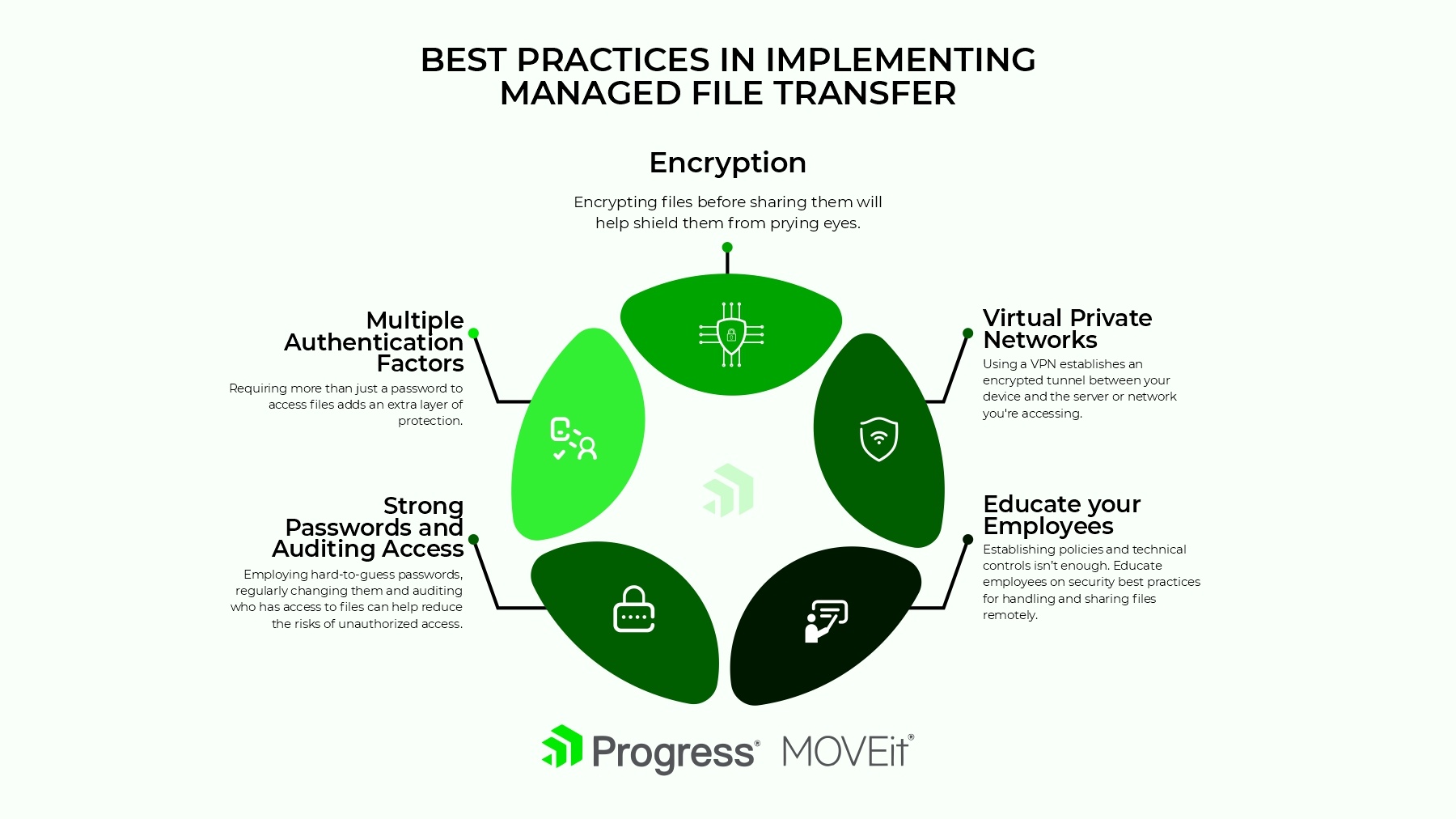Secure File Transfer: How to Avoid Risky Inefficiencies

It can be easy to accidentally share sensitive files in an insecure way. Secure file transfer software can help you reduce risk.
Have you ever stopped to think about how many sensitive files you share daily? In today’s world of hybrid work and dispersed teams, secure file transfer has become more crucial than ever. You’re sending financial reports to stakeholders, confidential contracts to clients and proprietary data to business partners. If any of those files fell into the wrong hands, it could be a disaster.
Unfortunately, it’s all too easy to be inadvertently negligent when transferring files. Emailing sensitive documents or using consumer file-sharing services may seem convenient, but those methods are risky. Email is not secure and file-sharing sites can be hacked. A robust managed file transfer solution can help safeguard your business’s data, especially in this age of remote work. Secure managed file transfer may not be the most glamorous topic, but it’s a top priority.
The Risks of Unsecured File Transfer Methods
Legacy file transfer methods like email and FTP are insecure and lack robust security features that can better safeguard sensitive data.
Here’s what I mean—email is not designed for transferring large files, and it lacks encryption. It also lacks tracking features to audit who accesses files and when. File Transfer Protocol, or FTP, on the other hand, is an outdated network protocol that allows for the transfer of files between systems in plain text. That means that if files are transferred via FTP with insufficient encryption in place, hackers could have a field day if they manage to get their hands on login credentials or access files. FTP servers are also difficult to patch and maintain, leaving vulnerabilities that allow ransomware and other malware to spread.
Other file-sharing methods like Dropbox, Google Drive or OneDrive are no better. Your files could end up in the wrong hands, shared publicly or even held for ransom. Think of the trouble, reputational damage and loss of competitive advantage that can happen if your data or intellectual property is compromised. It could be catastrophic.
Why You Need Secure File Transfer Software
Modern problems require modern solutions. When you see the pending issues—vulnerability, exposure, weak access controls, etc., you should understand why every organization that deals with sensitive data should consider adopting modern managed file transfer solutions. These solutions provide encryption to better safeguard data in transit and at rest, grant you granular access controls to help restrict who can access files and audit to track user activity. The best way to reduce file transfer risks is to replace insecure legacy methods with modern solutions focused on security and compliance.
Just in case you’re not convinced, here are some more reasons that highlight the need for you to get secure managed file transfer software for your business. Using encrypted file-sharing solutions allows you to:
- Set user permissions to better control who can access files. You can restrict downloads, prevent printing, disable editing, etc., so that sensitive data is available to only authorized users.
- Manage file access and sharing in one place. Rather than emailing files back and forth or using multiple cloud services, consolidate file sharing to a single secure solution. This makes it easier to control, monitor and revoke access if needed.
- Benefit from extra security features like two-factor authentication, single sign-on (SSO), audit trails and remote wipe capabilities in case a device is lost or stolen.
- Have help meeting data privacy regulations. Secure managed file transfer software has the proper controls and oversight required by laws like GDPR, HIPAA and PCI DSS.
- Gain peace of mind that your digital assets and intellectual property are better protected, even when teams are working remotely.
Key Features of a Secure File Transfer Software

What features should you look for in secure managed file transfer software? Here are some important ones:
- Encryption: Your files should be encrypted both at rest (when stored) and in transit (when being transferred). Look for 256-bit AES encryption or higher to better protect files from being accessed by unauthorized parties.
- Ease of use: An easy-to-use interface is a must. The solution should be intuitive for your end users to help encourage maximum adoption and productivity. Simple and straightforward solutions are more likely to be used properly with fewer errors.
- Audit logs: Detailed audit logs track file transfer activity and performance. They show who accessed what files, when and for how long. You can use this feature to access insights into how your system and data are being used.
- Error handling: Even with the most advanced technology, errors can occur. Your solution should have automated error handling to retry file transfers when issues arise, alert you to any failed transfers and quarantine or delete corrupted files.
- Ad hoc file sharing: In addition to scheduled or batch file transfers, you need a way to quickly and more securely share files on demand. Ad hoc file sharing allows you to upload files for one-time access or set up folders for ongoing collaboration.
- User management: Robust user management means you can better control who has access to files and what they can do. Set up groups, configure permissions, enable two-factor authentication and get detailed reports on user activity.
- Integrations: Choose a solution that integrates with the other tools you use like single sign-on providers, user directories and storage solutions. Integrations make the system easier to use and more effective. Look for a solution with an open API to enable custom integrations.
- Compliance: For many organizations, compliance with regulations like HIPAA, GDPR and PCI DSS is important. Look for a secure file transfer solution that helps support and maintain compliance with industry standards and regulations that affect your organization.
Implementing Secure File Transfer Best Practices

Like every industry in cybersecurity, secure managed file transfer has best practices—essential tips to keep at the back of your mind:
Multiple-Authentication Factors
Requiring more than just a password to access files adds an extra layer of protection. Using two-factor authentication, which combines both something you know (like a password) and something you have (like a security key or authenticator app), makes it much harder for unauthorized users to access your data.
Encryption
Encryption cannot be overemphasized. Encrypting files before sharing them will help shield them from prying eyes. Encryption converts files into unreadable code that can be deciphered by authorized parties who have the correct decryption key. Encrypting files both while they’re in transit (being transferred) and at rest (stored on servers) provides better protection for your data.
Virtual Private Networks
Using a VPN establishes an encrypted tunnel between your device and the server or network you’re accessing. This helps prevent snoopers from seeing your online activity and accessing your files. VPNs are especially important when connecting to public Wi-Fi networks.
Strong Passwords and Auditing Access
Employing hard-to-guess passwords, regularly changing them and auditing who has access to files can help reduce the risks of unauthorized access. Remove access for any users who no longer need it.
Educate Your Employees
Establishing policies and technical controls isn’t enough. Educate employees on security best practices for handling and sharing files remotely. Train them on identifying and reporting phishing attempts, using strong passwords and exercising caution when clicking links and downloading attachments.
Choosing the Right Secure File Transfer Provider for Your Business
Using a business-grade managed file transfer (MFT) solution helps you improve the security, compliance and efficiency of your file-sharing processes. MFT software offers robust security features like encryption, access control and detailed audit trails. It also centralizes and automates file transfers, saving your IT team valuable time and resources.
Rather than chancing business security with consumer file-sharing services, savvy organizations are turning to managed file transfer solutions. MFT software like Progress MOVEit provides bank-level security with features such as:
- Encryption: Files are encrypted in transit and at rest using the latest algorithms.
- Access control: Granular controls limit access to authorized users.
- Auditing: Detailed logs track file access, uploads, downloads and changes for accountability.
- Automation: Automated workflows allow for consistent, compliant processes for exchanging files both internally and externally.
A system like MOVEit encrypts files during upload, download and storage, so information is better protected even if intercepted. It also uses two-factor authentication to verify users before allowing access.

